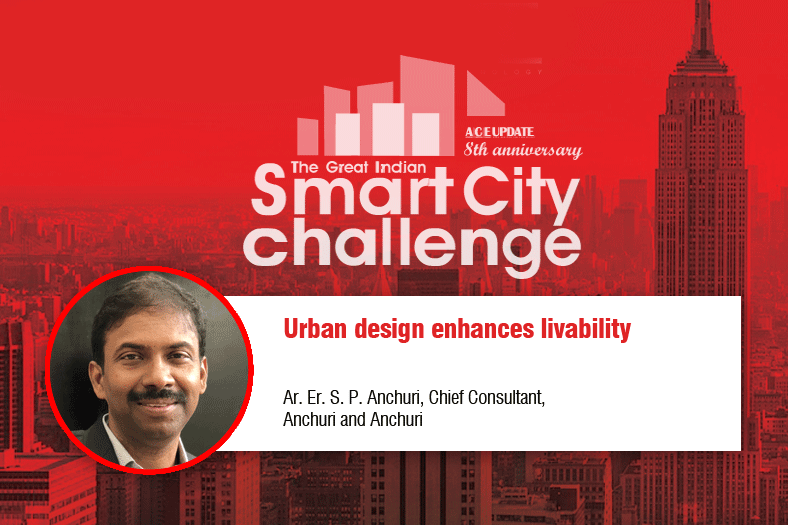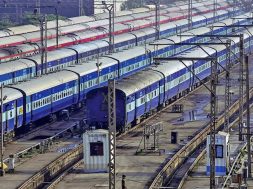Urban design enhances livability

Majorly cities around the world are coming up with innovative solutions to integrate urban land use, transport, energy and housing policies, for improving the lives of their citizens. To make cities and human settlements inclusive, safe, resilient and sustainable, implementing sustainable development agenda is imperative. More inclusive and integrated pathways to city and urban planning development have to be made in order to increase the opportunities at local, regional, national and international levels, according to Ar. Er. S. P. Anchuri, Chief Consultant, Anchuri and Anchuri.
What are the major challenges faced while developing smart cities?
Smart city initiatives have been researched principally in the developed country perspective like India. In developing countries, however, emerging technologies are enabling progress on urban functionality, productivity, and livability. More than half of the world’s population lives in urban settings and cities will therefore play an essential role in the sustainable development agenda to make cities and human settlements inclusive, safe, resilient and sustainable. This trend offers increasing opportunities for actors at local, regional, national and international levels to work together to develop more inclusive and integrated pathways to city and urban planning development. Cities around the world are coming up with innovative solutions to integrate urban land use, transport, energy, and housing policies, to improve the lives of their citizens.
Some of the common challenges facing smart city solutions today, and how developers can begin to address these barriers to success are: infrastructure, security and hackers, privacy concerns, educating and engaging the community, being socially inclusive, while most everyone can agree that smart technology has the power to make our lives much simpler – especially in highly populated urban areas – implementing that technology must be done in a carefully planned and highly secure manner. Rather than just focusing on what the solution can do, developers and tech companies must also consider how it will affect the people that come into contact with it. When technology, city governance, and communities of people come together to improve the quality of life for everyone involved, that’s when a city truly becomes “smart.”
There is a slew of challenges in developing smart cities. Trend towards urbanisation and transition to a new energy mix is likely to augment challenges in sectors like water. As every drop counts, digital solutions for water industry go easy on resources, optimise energy consumption, avoid water losses, prevent flooding, and perform predictive servicing and maintenance. Digital solutions can play a major role in staying on top of these demands and guaranteeing a reliable security of supply.
How smart cities are leveraging construction activities in Indian cities?
As we know, India is the world’s fourth largest energy consumer and it is envisaged that with this pace, the country will take over China in the next decade in terms of energy consumption. Energy efficiency measures will not hold true, if transmission and distribution woes are not addressed on priority. As per BEE’s assessment, lighting and air conditioners use 80 per cent of the energy in commercial buildings whereas fans and refrigerators consume maximum energy in residential buildings. In order to manage the energy to further optimise it, we need to know energy consumption at every stage. While we aspire to venture into new age of smart cities, it is imperative to know what is the state of different resources and their respective sources. If smart cities are designed keeping sustainability in mind, especially being mindful of being ECBC 2017-compliant, it is likely to benefit the whole system.
The planned mechanisms of area-based development in the Smart Cities Mission is retrofitting or city improvement, redevelopment like city renewal and greenfield development like city extension plus a pan-city proposal in which smart solutions are applied covering large parts of the city.
What is the suitable approach for urban accommodation in smart cities?
The suitable approach for urban accommodation and some typical features of comprehensive development in smart cities are – Promoting mixed land use in area-based developments – planning for ‘unplanned areas ‘containing a range of compatible activities and land uses close to one another in order to make land use more efficient; expand housing opportunities for all; creating walkable localities – reduce congestion, air pollution and resource depletion; promoting a variety of transport options; making governance citizen friendly and cost-effective; applying smart solutions to infrastructure and services in area-based development in order to make them better.
How do you look at the technology, products and solutions available for building world-class smart cities in India?
With technology integrated into new buildings as a rule rather than an exception, the digital age indeed seems to be upon us. The major driver for innovation in this sector has been the trend in energy and sustainability with “IoT” intelligent buildings monitoring resource consumption, boosting efficiency and reducing energy costs. More and more technologies, products and solutions available for building are integrated into urban design, reaching from basic elements such as in case of digital technology LCD screens instead of traditional billboards to embedded technology leading to trends in smart buildings and computer automation.
Urban connectivity is rapidly growing in importance for urban design. By digitally connecting public transport, social services, health and public spaces to increase accessibility and create higher efficiency, the face of our cities will continue to visibly have key trends in the evolution towards a more digital world.
What are the existing and emerging trends in designing smart cities?
In designing smart cities, the architecture is designed in such way that it adapts to the specific needs of each city, enabling cities of any size to use only the resources they need. Urban design plays a crucial role in creating engaged and connected cities, helping facilitate human interaction and shared experience.
Going green is important as our public spaces are at the heart of democratic living. Incorporating nature into traditionally urban spaces such as rooftops create a feeling of the outdoors without the need to leave the city. Re-urbanisation is also a step towards smart city movement. After decades of affordable land release and large residential blocks, there’s been trend towards “reviving” urban centres. We see how society is moving away from the house and land suburban emptiness and re-embracing cities as the knowledge and innovation-based economy becomes ever more dominant. Subdivision, smaller block sizes, zoning changes and infill development are all regulatory measures that have been implemented in various measures to repopulate India’s urban areas. The ‘retail reinvention, future proofing, walkability, inclusion of personal sanctuaries are to be carefully considered in smart city development.
Shifts in our environment, demographic changes and technological advances demand re-thinking of traditional urban design. Less available space leads to smaller units and living areas. In response to overstimulation and lack of privacy, people often look for personal space outside of their home in areas such as workplaces, retail and residential environments.
Trend towards urbanisation and transition to a new energy mix is likely to augment challenges in sectors like water
Ar. Er. S. P. Anchuri, Chief Consultant, Anchuri and Anchuri
Cookie Consent
We use cookies to personalize your experience. By continuing to visit this website you agree to our Terms & Conditions, Privacy Policy and Cookie Policy.







